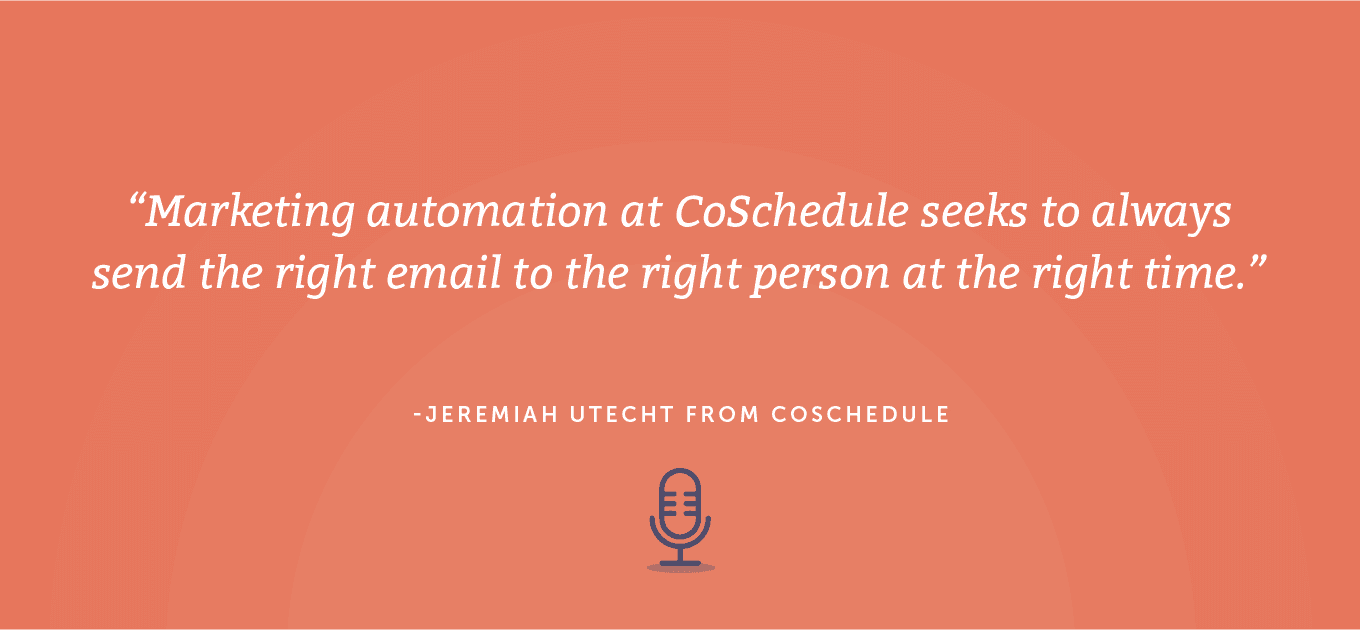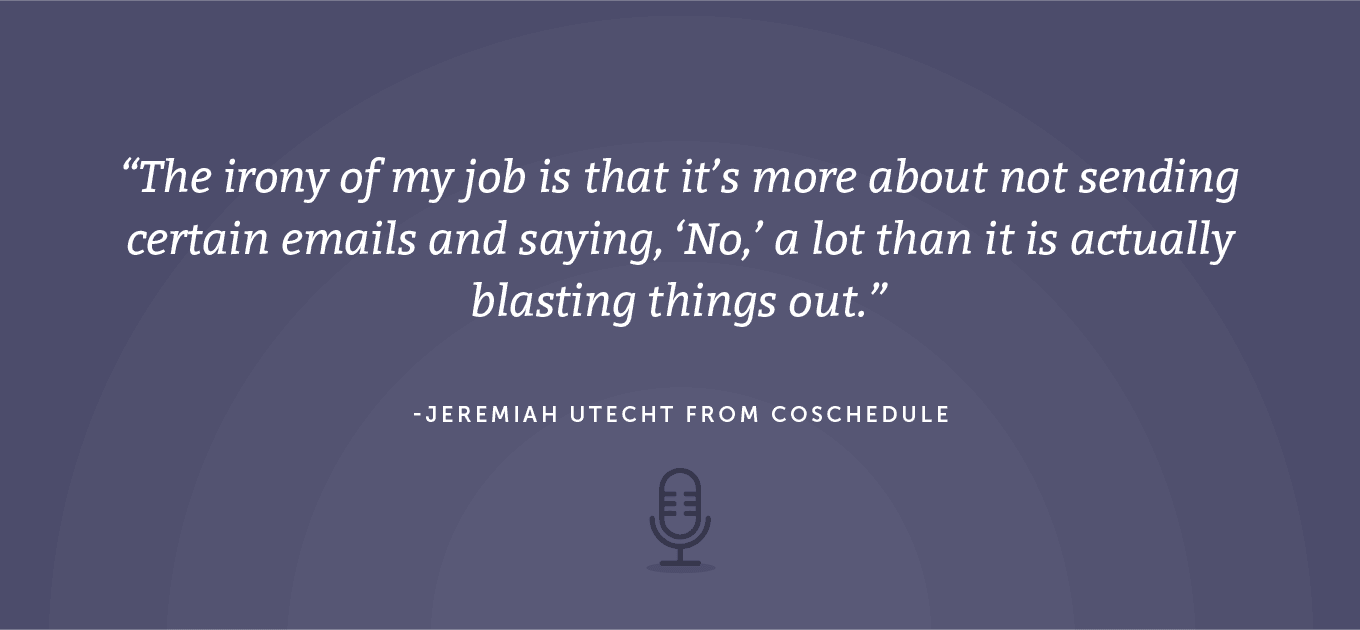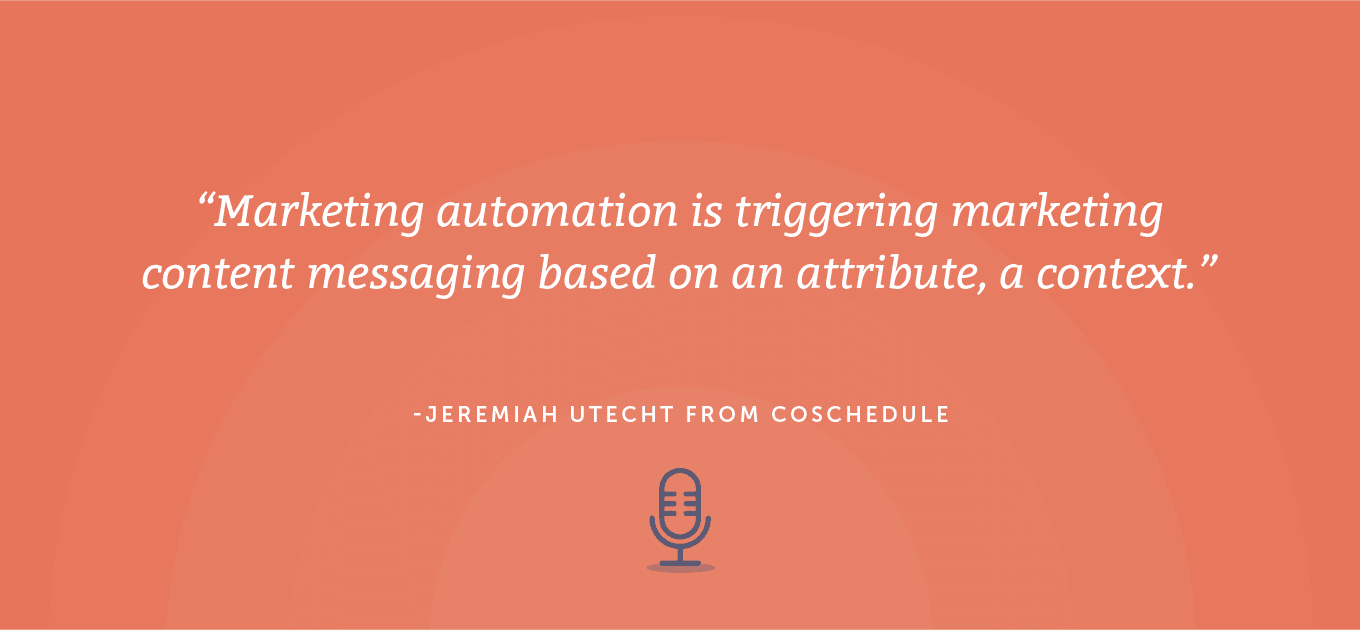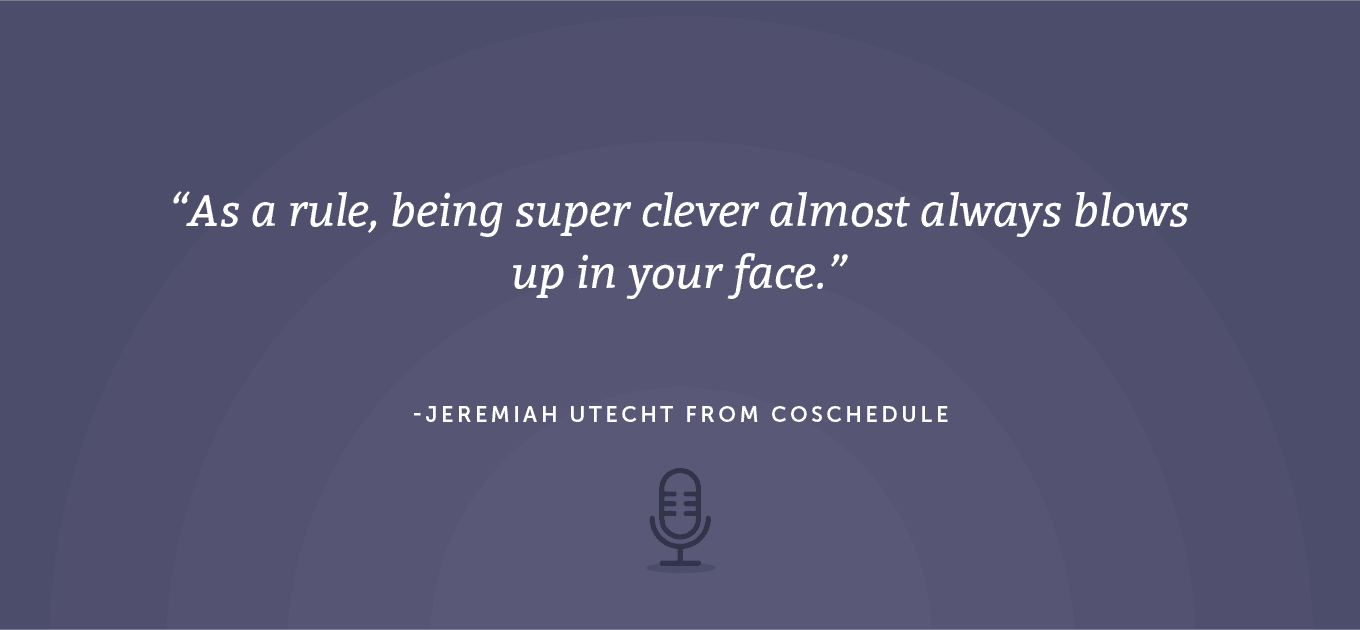What does email automation look like, how does it work, and what are its benefits? Discover how to grow, scale, and mature by owning and not making the same mistakes.
Today’s guest is Jeremiah Utecht, Lead on Marketing Automation and Business Intelligence at CoSchedule. He takes the mystery out of marketing automation and makes it work.
[podcast_motor_player]
Some of the highlights of the show include:
- Jeremiah’s Role: Build, maintain, and refine CoSchedule’s email marketing
- CoSchedule’s Mission: Send the right email to the right person at the right time
- Happy Anniversary! Marketing automation message triggered by attribute/context
- Marketing Automation Internally: Means most relevant content at relevant time
- Successful Multi-Channels: Website customization and email for CoSchedule
- Clever or sophisticated? Trial-and-error process for practices/platforms that work
- Automation Attributes: Anything is possible with simple and flexible forms
- Oops! Emails: Marketing automation at scale is an incredibly unforgiving practice
- Communication and Confidence: Freeze, validate, test, isolate, fix error, move on
- Data Manipulation: Start small, create email list, and capitalize on investment
- Benefits: Marketing automation is data driven, use tools to try and test emails
Links:
- Jeremiah Utecht on LinkedIn
- MailChimp
- Ben Sailer on LinkedIn
- CoSchedule
If you liked today’s show, please subscribe on iTunes to The Actionable Content Marketing Podcast! The podcast is also available on SoundCloud, Stitcher, and Google Podcasts.
Quotes from Jeremiah Utecht:
- “Marketing automation at CoSchedule seeks to always send the right email to the right person at the right time.”
- “The irony of my job is that it’s more about not sending certain emails and saying, ‘No,’ a lot than it is actually blasting things out.”
- “Marketing automation is triggering marketing content messaging based on an attribute, a context.”
- “As a rule, being super clever almost always blows up in your face.”
[Tweet “Demystifying Marketing Automation and Making It Work for You With Jeremiah Utecht From @CoSchedule”]
Transcript:
Ben: Hey, Jeremiah, how’s it going this afternoon?
Jeremiah: It’s a good day.
Ben: Yeah. It’s warm and sunny in North Dakota, so I can’t complain. We obviously know each other really well and work together pretty closely. We are actually sitting maybe 100 feet apart in the same office right now with some audio isolation here in our podcast studio.
I just want to make sure that I don’t misrepresent what it is that you do here because I understand the benefits of it, more so than I understand the actual technical implementation. For our listeners, would you mind introducing yourself quickly and then just explain in as simple terms as possible what you do for us here at CoSchedule?
Jeremiah: Like what was mentioned earlier, I’m Jeremiah Utecht. I’m the Lead of Marketing Automation here at CoSchedule. Really, if I was going to distill it down or if I was going to explain it to a five-year-old, I’m the person in the back of a conference or in the back of a church that changes the slides. Nobody knows I exist until I mess up and then everybody knows I messed up. It’s just a marketing term.
Largely, the vast majority of my time is spent building, maintaining, and refining our email marketing and how that works. Our mission statement (I think) encapsulates everything really well which is marketing automation at CoSchedule seeks to always send the right email to the right person at the right time.

Actually, the irony of my job is it’s more about not sending certain emails and saying no a lot than it is actually blasting things out.

Ben: Sure. I will say that for myself, having been here at CoSchedule for about 5 ½ years now, blasting things out and applying brute force to our email list was very much the old-school way that things were done when we were a bit less sophisticated. I’ve been able to see from having you be a member of the team just how much you’ve really transformed our email marketing practice in general. It’s been really remarkable.
To broaden the scope of the conversation a little bit, marketing automation is a term that can mean a lot of different things and a lot of different people working under different circumstances. Where people’s minds default to when they hear marketing automation can vary wildly between folks.
I think you’ve already touched on this a bit, but could you go a little bit deeper into what exactly does marketing automation mean for us at CoSchedule? When we talk about marketing automation internally, what are we talking about?
Jeremiah: Sure. It’s probably actually easier to distill it down to the simplest definition and then build up from there. Marketing automation is triggering marketing content messaging based on an attribute, a contact.

A really simple example would be an anniversary message that you send to a contact on their kick day if you’re a Reddit user or you signed up for the app. That’s at its very simplest.
For us, we have a pretty robust practice, but we’ve really concentrated on our channels. For us, it’s showing the right CTAs on the website, showing the right CTAs and emails, showing the right content, making sure that we’re not overloading our contacts with too many emails, and really just making sure that we’re really surfacing up the most relevant stuff at the time.
That touches on the multi-channel aspect. You can get into SMS marketing, you can get into push notification marketing. There are all these different channels we have access to, but for us, we’ve had a lot of success with website customization and email.
Ben: Sure. We also touched on this a little bit. Marketing automation for us at CoSchedule has evolved dramatically (certainly) in the last five years.
Jeremiah: Yeah. When I was brought on to the team, we were using a platform that has since pivoted and that doesn’t actually do marketing automation anymore. We were in that weird, awkward adolescence where we knew we needed something more robust. We knew we needed to increase our sophistication and so we tried to be super clever with how we did things. But as a rule, being super clever almost always blows up in your face.

It was a lot of trial and error. It was a lot of trying to figure things out. I do have a background in business intelligence, so I was applying a lot of those practices to try to figure out what was and wasn’t working.
We have since moved on to a more complicated, much more robust platform which is amazing, but it feels like every month, I’m learning something new that it can do or quirks with it.
A lot of it is around economy and efficiency of effort. We only have so many marketing leads. We only have so much content that we can create in a given month. How can we create marketing automation sequences that make the most of that content in a way that gives everybody the freedom to focus on the things our bosses are asking us to do?
Ben: Something in there that is really interesting is that it’s easy to think of marketing automation as being something very complex. It is complex, so I think it’s interesting that you say that trying to get too clever more often just gets you in trouble.
Just to really drill into that point, how do you find the balance? I don’t even know the best way to put it because none of it really seems that simple necessarily. That may be a misunderstanding on my part because there’s so much stuff that you can do, and all of these different things that you can think of or dream up that might sound really interesting.
How do you really narrow down what you are capable of doing, what’s actually going to be most effective, and what is maybe the least likely to blow up in our face, so to speak?
Jeremiah: The principle I follow for myself is if I can’t explain it to a five-year-old, it’s probably too complex. It has nothing to do with the supporting teams on the data side and has nothing to do with the market.
I’m constantly pushing the marketing leads to come up with new crazier ideas for me to try to figure out how to implement just so that we’re always pushing ourselves, but (really) it comes back to that mission: who do we want to send the content to, why do we want to send to it them, and when do we want to send it?
The environment I work in is probably far more complex than the 95% of marketing teams are going to be working on. I’ve got literally hundreds of attributes that we track on contacts depending on their state, which apps they’re using, and everything else, but that’s all just window dressing on top of who is it, what is it, and when is it?
If you can answer those questions really solidly, then you’ve got a really good case for what you’re trying to do. It really is about when anything is possible, it really does come down to simplifying things into the simplest possible form. Those simple forms tend to be flexible.
We can do things, like if a person signed up on this date, they did this thing at this time, and they looked at this page on the website, we can cobble—we’ve done that before—all of these attributes together to create this really complex targeting. But it gets really brittle. By brittle, I mean if one thing in that stack goes wrong, then it’s possible that either the contact won’t get the email when they should, even the automation itself could fail, or the worst case is it just starts blasting people silently in the background which is always my nightmare.
Through our practice, we learned that keeping everything as simple as possible just has been probably the best thing we’ve ever done.
Ben: I think it makes a lot of sense to at least keep the guiding principles that drive everything as simple as possible. I imagine that that lesson has been somewhat hard to learn, having to go through a lot of trial and error to arrive at a place where you really do have that process and the philosophy that underpins that process, and getting it to a point where it is dialed in as well as it is today.
What are some of the biggest challenges that you faced when you’re working to mature and scale our marketing automation practice?
Jeremiah: Probably, the thing you have to realize about marketing automation—especially with marketing automation at scale—is it’s an incredibly unforgiving practice. It’s an unforgiving role in a company.
When I mess up, my CEO, my boss, my boss’s boss, and my boss’s boss’s boss all know I messed up. That’s really not for everybody because if you’re terrified of making mistakes, you’re going to make mistakes. It’s really been about building practices around making sure the content you’re sending out is as absolutely good as possible.
We had a mistake last week. It was a quirk with the AR-testing environment versus the production environment. I had to tweak our process to make sure that we don’t make that mistake again.
I hate sending out oops emails. It’s one of the one of my least favorite things in the world to do, but as the lead, I own it all. It’s my job.
It’s really about making things that are habitual. Every time we build a targeting source, we validate it and we try to break it. Like what are the corner cases that would make this not work? Then, we validate it with both the marketing stakeholders and then I’m fortunate enough to have a technical team I can call on at any time to send to them to also validate.
We do some incredibly complex targeting at times. I know I just need to keep everything simple, but sometimes that’s not an option. So when I do those incredibly complex maneuvers, I always have a technical team that I can count on to take a look and check my work to make sure that I didn’t miss something.
It’s really the old carpenter adage, “Measure twice, cut once.” It’s really that applied to marketing. You just got to have to be really diligent.
Ben: Jeremiah shares so much interesting insight and so much valuable advice throughout the course of this conversation that is just incredible, but one thing that I really want to shine a spotlight on is the idea of keeping things simple. With marketing automation and with lots of things in marketing in general, things can get really complicated really quickly.
When things get complicated fast, it can be very easy to feel overwhelmed. Whether you are automating your email marketing practice, whether you’re doing anything else that you’ve maybe never done before, something that you feel like you’re struggling with, or figuring out how you can break it down to its absolute, most basic elements of what you are trying to get done, the easier it can start to make everything feel.
For us with email automation, we want to deliver the right content to the right people at the right time that is super simple to understand. It’s much simpler to understand than a very complex, convoluted explanation for how email marketing automation works in general. That’s really taking what we are trying to do and breaking it down into just three very simple concepts.
Something I would challenge you as a listener to do is if there’s anything that you’re feeling overwhelmed with right now, how can you do the same thing? How can you narrow it down to just three simple points, just three simple principles that guide what you’re trying to get done? I feel like if you can do that, everything else suddenly starts to look a lot more clear.
Now, back to Jeremiah.
Ben: It’s a really good point that you make. If you fear making mistakes, you’re ironically more likely to make mistakes. You have to have some degree of confidence in yourself and in what you’re doing.
Say a mistake happens, how do you handle that in that situation? Mistakes happen for all of us in every area of the business, but with automation, when there’s an error, like you said, it’s very noticeable to lots of people. I feel like that’s a degree of pressure that you might have probably more so than myself, maybe more so than some other areas of the company.
I’m just curious, how do you approach rectifying those things? Beyond just making the technical fix—not to smooth things over internally—how do you communicate with people who need to know what’s going on internally to make sure that everybody’s on board with getting that error solved?
Jeremiah: We’ll use last week as an example. The CTA links and an email didn’t work which is the entire point of the emails.
The support team reached out to me first thing in the morning. The first thing I did was try to freeze the sending processes of those emails and I caught them five minutes too late. I think between 60,000 and 70,000 emails have gone out.
We freeze everything. That automation sequence is frozen until I release it. Then, we validate all of the work we did around that. We check it against our best practices. I check it against our coding processes. We use a built-in scripting language that can be a little finicky at times.
Then, I isolate the error, I communicate that I found the error and I know what the fix is going to be, and then I give the support team (in this case) a link that they could send people so they could click it and get the deal.
Amongst that, I communicate to the lead that owns the project and I communicate to my director that this went out. The last thing I want to do is have my director’s boss ask him about it and for him to have no clue. That’s a really bad thing to do.
Own your mistakes, especially in this. You got to own your mistakes because everybody’s going to know anyway. Get in front of it and get on top of it.
Once that was done, we went through. I edited all the content, I communicated with the individual that wrote the content, owned up my own mistake in the QA process that I should have done things differently and I didn’t, update everything, unfreeze it, and then obsessively check everything that goes out for the next week because now I’m paranoid.
It doesn’t matter what the mistake is, but that’s the process, which is to stop the bleed as fast as you can, stitch the wound, dress it, and then continue on.
If you have a small list of 5,000–10,000, it’s very valuable. Those are precious contacts, so you want to be diligent and careful, but you’re also probably not working with things like scripting languages and more complicated things.
It’s a really good lesson as you move forward. We very rarely send email to our entire list. It’s Murphy’s law of making mistakes. It’s a function of time. The longer you go without making a mistake, the more likely you are to do it so you just don’t want it to happen, like blasting over a million contacts. That’s when it gets really, really bad.
Again, it’s about trying to make sure that things are highly targeted. That’s fewer people being sent to. All those automations are our top-performing. The tighter our targeting is, the fewer people we’re sending it to, but the more response we get. It’s about building a portfolio of those. If any 1 given automation fails or has an error, it’s 60,000+, not 1.5 million. It kind of keeps the scale controllable.
Ben: Sure. I think that all makes sense. It’s very valuable advice even if it’s just a reminder for everybody working in any area of marketing or really just in any walk of life. You’ve got to own your mistakes. There’s no sense denying it when the evidence is out there.
It’s awesome to dig into your own experience and to share that with our audience, but in your opinion, if a marketing team is considering getting more invested in marketing automation, keeping notes in the scope of this conversation, let’s assume that they’re talking about marketing automation in terms of email automation. They want to take a basic email marketing practice and they want to get a bit more intelligent with it. How would you say they can know when it’s time to make that step?
Jeremiah: Honestly, I would say as soon as you have an email subscriber list, you should start building the fundamental small parts. Even really fundamental tools like MailChimp have really basic automation tools in there.
Those anniversary emails, birthday emails, and all of those things you just need to fire off because you can’t just do them every day. Start getting those things going because it’s one of those little things that are like little pebbles. One little pebble makes no difference, but 5000 does.
If you can start building those little practices as your business grows and as your audience grows, hopefully you’re going to have the revenue to start investing in more sophisticated tools and you’ll have more data to work with. I would say as soon as you have an email list, you should start looking at at least the bare fundamentals.
It also is a really good idea because you can start building those skills and that knowledge prior to if you try to go hire just somebody who’s strictly an automation expert, that’s very expensive. It just gives you the ability to—depending on where you’re at in your business’s journey—start capitalizing on that without a massive investment.
Ben: I really liked that idea of laying the groundwork right away even if it is pretty basic because you’re going to need something to build on top of.
Let’s say this marketing team has heard that advice, they’ve taken that much to heart, they’ve made a determination that automation is something they should move forward with, and they’re starting to put the rudiments into place with whatever platform it is that they’re implementing. Once they’re up and running, what’s the next step? At what point would you say it does make sense to actually hire technical staff to manage their email automation?
Jeremiah: I would say that you should really strongly start considering a technical asset on your marketing team for this when you need to do what’s commonly called data manipulation. It would be things like lead scoring engines and a really heavy, tight CRM integration where you’ve got tons of data points and now you’re going to want to do more complicated things to really narrow it down. Maybe you have an initiative to push prospects to leads or leads to customers and you’re going to use a bunch of different data sources to do that to really make it really tight.
That quickly starts getting really complicated. Typically, it will require some scripting or database knowledge to really do that well. That’s when you should start thinking about a technical person.
I actually come from a project management customer success background. I just happen to know how to do SQL and JavaScript. When I moved into this role because I’m just an insatiably curious person and had the business intelligence experience, I was able to apply a lot of that stuff to marketing automation and then build those practices up. Then I just fell in love with the discipline in the midst of it.
When you need to do data manipulation, you’re not just targeting a CRM on a flag state, but it’s a contact. The company’s gross revenue is above X. They have X number of employees, they’re in this vertical. Their quarterly earnings report is coming out at this time, so we want to hit them in relation to that. That’s a really complex picture.
You can boil it down to really simple terms, but for data wise, that’s a whole bunch of different things that you are trying to synthesize into one thing. That typically almost always requires somebody with some technical know-how.
Ben: I love the way that that just makes it super simple and super concrete. Once you get to the point where you’re manipulating data, that’s the point in time where you got to hand this off.
I love how clear that makes it rather than giving people a semi-ambiguous, well, it depends. I feel like with so many things with marketing, it depends is maybe how a lot of more nuanced answers to things start, but I think (at least in my opinion) for people that are unsure of what they’re doing, it’s not particularly helpful. I love the way that you’re able to sum that up.
The last question I’ll throw your way, once a marketing team gets up and running with the right tools, they have the right people in place to administer those tools, and have a good strategy for what they want to achieve through marketing automation, what are some of the benefits that they can expect to see over time as they mature their automation practice and as their business starts to grow?
Jeremiah: The amazing thing about marketing automation is because it’s technical, it’s data-driven. We are constantly testing subject lines. We are constantly testing preview text. We’re constantly testing voicing, positions, and all of these things as marketers that we worry about, but I’m the one putting them into the field. My tools allow me to pull that data back and say for a brief while, if we threw a GIF into an email, that guaranteed a click rate that was way high, and you could watch that taper off over time as GIFs became ubiquitous.
We’ve tried emotional language and analysis on our subject lines. It really gives you the freedom once you have all that data and you build up the baselines, you can do crazy things. Take a subject line that absolutely shouldn’t work and maybe could be seen as risky. You can do a limited test to see how your audience deals with it or how they respond to it.
It really gives you all the tools necessary to test different branches that you wouldn’t otherwise because if you don’t know exactly how your audience is responding, we tend to be a little more conservative.
The other thing is as you’re able to build, tailor, personalize, and make content that works, you can go to management and say, hey, here are our open rates. Here are our clickthrough rates. Here is all the data that says how this is working. As a business, possibly, we should consider these things because this is where the data is leading.
I have a lot of surprising conversations with our head of marketing just around what I’m seeing in the data that may indicate that maybe we should try something that we hadn’t thought of before.
The thing I want to make sure we wrap that’s included is that marketing automation is a lot like the ocean. If you’re in the ocean, you can’t take your eyes off of it. Something is always breaking. Something’s always not quite right.
Marketing automation is not set it, forget it. At least once you have any level of sophistication, it’s like an engine. Right now, I think I have just shy of 50 different automation sequences that I’m shepherding (for lack of a better description) making sure they’re working exactly how they’re supposed to. Anytime we do a new product launch or we change the core business fundamentals, it’s a big engine pushing us forward. More often than not, when I’m not making something new, I’m tinkering and keeping everything running smoothly because it seems like the second I take off for more than a week of vacation, something’s guaranteed to go wrong.
Ben: That really does seem to be the way things work out.
Jeremiah: Yes. Again, back to that, keep things simple.
Ben: Right. Good advice. That’s all I got for you, Jeremiah. Thanks so much for taking some time out of your afternoon to share your insights with our audience and with myself into how marketing automation works here at CoSchedule. I’ll see you down the hall in a minute.
Jeremiah: Yeah. I can shoot you with a Nerf gun from my desk.
Ben: You could, but please don’t.
Jeremiah: I won’t. I’m too old for that.
Right. On that note, I’ll let you go. Thanks again so much for jumping on the show.
Jeremiah: Absolutely. Thank you very much.

The post Demystifying Marketing Automation and Making It Work for You With Jeremiah Utecht From CoSchedule [AMP 249] appeared first on CoSchedule Blog.

![You are currently viewing Demystifying Marketing Automation and Making It Work for You With Jeremiah Utecht From CoSchedule [AMP 249]](https://www.dimaservices.agency/wp-content/uploads/2021/08/249_Jeremiah-Utecht-Podcast-Graphics_header.png)
![Read more about the article What Marketers Can Learn From Nonprofits About Building Brand Advocacy (and Why They Should Start Now) With Spencer Brooks From Brooks Digital [AMP 214]](https://www.dimaservices.agency/wp-content/uploads/2020/12/214_Spencer-Podcast-Graphics_header-300x128.png)

